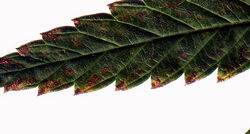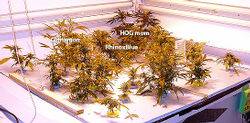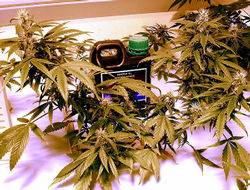G
Guest
It is a odd one for sure, but JAT is correct, its sister is just moving along, but they aren't putting on a lot of fur yet. This is, my guess, due to the fact that they are seedlings and that they are a heavily Sativa dominant strain.
Agreed, I'd expect more bud development (its definitely odd) but it is growing now very strong...just taking a very long time. It might just be a 10-12 week flowering strain that is all. I've heard of them taking up to 3 months sometimes. So it doesn't freak me out. She isn't sick at all. Just very slow and methodical.
Her matured clones should do much better I'd think. I like the strength she has in her branches...very good vascular system and nodes cut off with the callus nob they grew out of. We'll just have to keep an eye on her. My Oasis was the same way, totally out grown by every strain on the table, until she was ready...they was the tallest and meanest of all of them.
But as the tallest plant on the table that Cinnamon isn't sick by any means. I'm actually considering topping her again as the 'Peace Sign' is getting huge and she still has more branches on these two fingers.


And she is getting buds...just not rapidly. Her sister isn't packing that much more and is a lot smaller. I think it is just the difference between topping early and then later. The queer one had to stop for a week or two to deal with being topped in the middle of stretch and I'm not running a solid 12/12 yet. I was bring them down at around 13-14 hours of daylight so they might just be longer sats to flower.


JAT - I told you. Its about to get seriously mad for you. I'm gigglin' myself silly. But those tables make me jealous I don't have two identical ones in my guest-room. :smile:
Its about to get seriously mad for you. I'm gigglin' myself silly. But those tables make me jealous I don't have two identical ones in my guest-room. :smile:
But speaking of the ph..I have that same issue. Every couple days or daily, depending, the ph drifts up to 6.0. Maybe that is the point it should be at and we are just fighting it, as I'm only seeing K def if any...higher ph wont effect that adversely.
Not only are these two a little more mature, but they are more Indie dominant as well. I think the Cinnamons are meant to be trees. The Peacekeeper looks like she could easily grow 5-7 feet given the chance.


Agreed, I'd expect more bud development (its definitely odd) but it is growing now very strong...just taking a very long time. It might just be a 10-12 week flowering strain that is all. I've heard of them taking up to 3 months sometimes. So it doesn't freak me out. She isn't sick at all. Just very slow and methodical.

Her matured clones should do much better I'd think. I like the strength she has in her branches...very good vascular system and nodes cut off with the callus nob they grew out of. We'll just have to keep an eye on her. My Oasis was the same way, totally out grown by every strain on the table, until she was ready...they was the tallest and meanest of all of them.
But as the tallest plant on the table that Cinnamon isn't sick by any means. I'm actually considering topping her again as the 'Peace Sign' is getting huge and she still has more branches on these two fingers.


And she is getting buds...just not rapidly. Her sister isn't packing that much more and is a lot smaller. I think it is just the difference between topping early and then later. The queer one had to stop for a week or two to deal with being topped in the middle of stretch and I'm not running a solid 12/12 yet. I was bring them down at around 13-14 hours of daylight so they might just be longer sats to flower.


JAT - I told you.
 Its about to get seriously mad for you. I'm gigglin' myself silly. But those tables make me jealous I don't have two identical ones in my guest-room. :smile:
Its about to get seriously mad for you. I'm gigglin' myself silly. But those tables make me jealous I don't have two identical ones in my guest-room. :smile:But speaking of the ph..I have that same issue. Every couple days or daily, depending, the ph drifts up to 6.0. Maybe that is the point it should be at and we are just fighting it, as I'm only seeing K def if any...higher ph wont effect that adversely.
Not only are these two a little more mature, but they are more Indie dominant as well. I think the Cinnamons are meant to be trees. The Peacekeeper looks like she could easily grow 5-7 feet given the chance.


Last edited:







 Started off with 25 gals ro, hydro guard @ 10ml per gal, cal mag to 250 ppm, pbp grow to 490 ppm, set ph at 5.6 but already drifted up to 6 overnight.
Started off with 25 gals ro, hydro guard @ 10ml per gal, cal mag to 250 ppm, pbp grow to 490 ppm, set ph at 5.6 but already drifted up to 6 overnight. 













 The victory will be for the survivors! I can't wait to see those 'Twins' bustin out of their little dinky closet. You'll all get to see what I've been raving about how if you ignore them for a few days they'll literally get out of the pods and come looking for you for food.
The victory will be for the survivors! I can't wait to see those 'Twins' bustin out of their little dinky closet. You'll all get to see what I've been raving about how if you ignore them for a few days they'll literally get out of the pods and come looking for you for food. 







